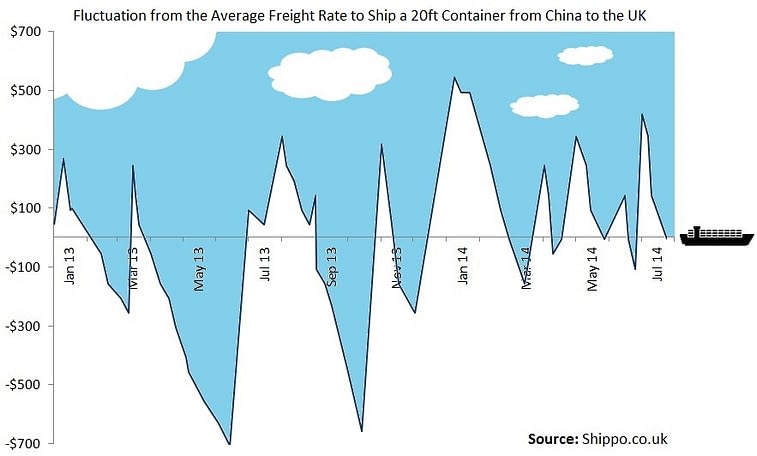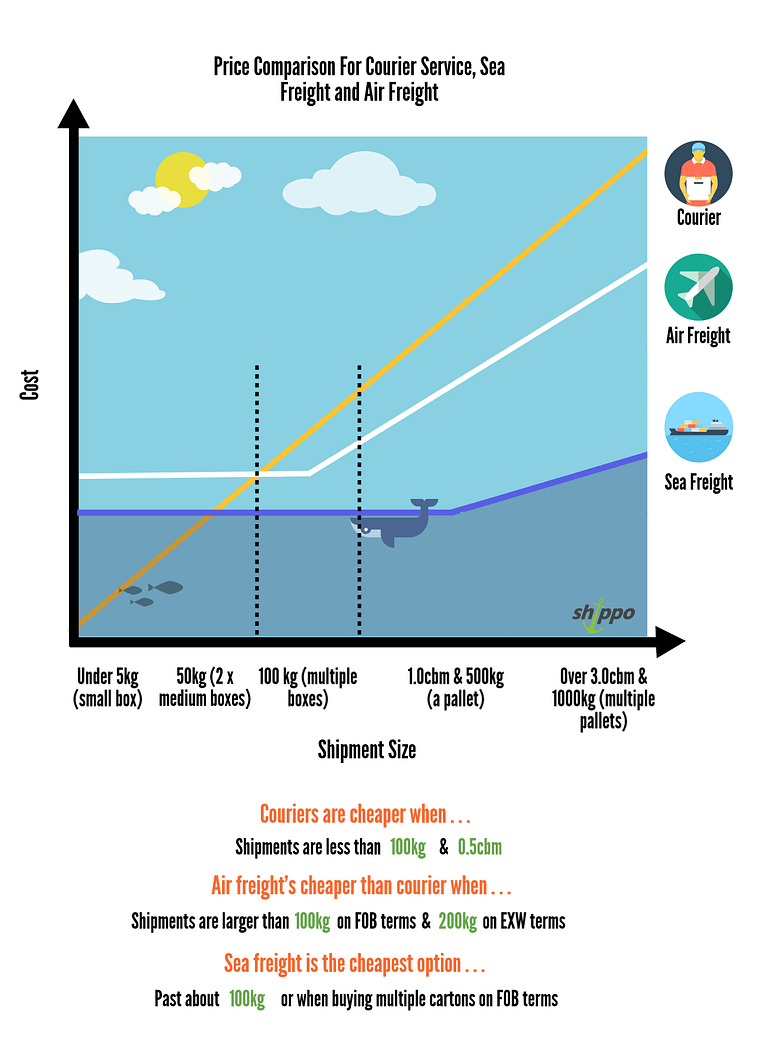Sea Freight Costs Explained
You’ll need to know how much sea freight costs before importing from China, India or elsewhere else!
A lot of the time you may receive very varied quotes on what you’re required to pay – but, before you rush in thinking you’re getting a great deal, you need to understand the process of importing goods from China to the UK. Once you understand the import fees, how much it costs and why, you can really see if you’re getting a good offer . . . or if there’s something dodgy going on. There are a lot of sea freight charges that need to be covered!
We try to make our sea freight prices as simple as possible, but the below information is what you will need to get a quote from any shipping company:
- Weight and Dimensions/Volume of your goods
- Shipping terms that your supplier is offering (FOB, Exworks etc.)
- The outbound port (where the goods are coming from)
- Where the goods are being delivered to (location of your door!)
Sea freight costs are calculated by the volume or the weight (whichever is greatest). It’s normally the volume, which is why we need to know the dimensions of your shipment to get you a price.
The industry uses the technical term “Weight or Measure” – often shortened to “w/m”. This means that 1.0 cubic metre (cbm) is equivalent to 1000kg. It’s rare that the weight is so heavy that it indicates the cost, but if your shipment was 2.0cbm and 2500kg then the weight is greater than the volume. If it were 2.5cbm and 2000kg, then the volume is greater so the sea freight shipping rate would depend on that.
- Different Ports Mean Different CostsSea freight rates vary from port to port. This can be due to a number of reasons, but it’s a good idea to know which port/s your supplier uses so you know the exact sea freight cost. If you’re shipping a pallet of goods from Guangzhou and your supplier is between the two, you could save money by importing it from Shenzhen which is less than 100 miles down the road.Why the difference?
The size of the port is often a factor in the cost to ship goods by sea freight. Shanghai, for example, is the world’s busiest trading port which handles 32 million containers each year and therefore is cheaper than other Chinese ports due to economies of scale. Some ports, such as Zhongshan, don’t have services that run directly to the UK, so we have to arrange for a ‘feeder’ vessel to Hong Kong where the container is loaded onto the main ship; this additional transit would be an extra sea freight charge. Along with geography, these factors can cause the sea freight rates for shipping goods from China to vary quite a bit, so it’s always best to check if you have options with your supplier.Land lockedWhen importing goods from India, the factor of geography becomes very apparent. The two main ports that are used when importing from India are New Delhi and Mumbai. “But New Delhi is 1000km from the nearest sea” I hear you say . . . And you’d be right! As a result, the containers from the New Delhi CFS (Container Freight Station) have a sizable journey before they can be put on the boat ✔️ and that’s why the sea freight rates to import goods from New Delhi is often double what it’d be to import goods from Mumbai.You should bear in mind that these fluctuations should only be minimal in the total shipping cost as, on FOB shipping terms, all the UK charges will be the same, so it may only make a difference of £10-20 per cubic metre, but every little helps.
Sea Freight Rates – Why so Unstable?
Why are the sea freight rates from China so unstable?” is one of the questions that crops up a lot when discussing full container load (FCL) shipments.
Part container load (LCL) shipments are not subject to such fluctuations. If you’re not shipping enough to fill a full container, it’s not likely that your shipping costs would vary by more than about £5-10 per cubic metre from month to month.
It’s not all Smooth Sailing for Full Container Loads
When shipping a full container, it’s very important to understand how the sea freight rates can vary. You could be left out of pocket if you don’t allow for rate fluctuations in your calculations. Before we try to explain the instability for FCL shipments from China to the UK, perhaps it’s best if we show you the statistics. The below graph shows how the sea freight shipping rate to import a 20ft container from China to the UK fluctuated from the average between January 2013 and July 2014:

As you can see from the graph, the sea freight rate for a 20ft container shipped from China to the UK varied by USD$1150 in a three month period from October 2013 and January 2014. If you checked the rate in October, based your calculations on that, commissioned your goods to be made (which may take 12 weeks) and then were ready to ship in January, then chances are you’d be pretty annoyed.
Why Are Sea Freights Rates So Unstable?
The reason for these huge peaks and troughs (increases and decreases in sea freight shipping rates) come as a result of the shipping lines artificially increasing the rates using large general rate increases (GRIs). These are implemented by all the shipping lines in order to stop the falling sea freight rates. Unfortunately, the volume of containers being shipped is rarely enough to hold the rate in its inflated state so the shipping lines then have to decrease their rates again to win business.
….. Until the rates are too low and the cycle continues.
- Air and Sea Freight CostsA major factor when deciding the method of importing your products to the UK is usually the import charges. Sea freight is usually 4-6 times cheaper than air freight.When you’re deciding between traditional air/sea freight and a courier service (FedEx etc.), you will be best with a courier up to about 100kg in chargeable weight. When the shipment is larger than that, traditional air or sea freight will be most cost effective.Weight is 6 times more dominant in air freight than in sea. 1 cbm (cubic metre) is equal to 1000kg in sea freight but for air freight 6 cbm is equal to 1000kg. If the weight of your cargo increases and you’re shipping by sea, it’s unlikely that the rate will increase much if at all. If you are importing heavy cargo via air freight, the cost difference between the two options will widen to much more than usual 4-6 fold.
 How do you calculate the chargeable weight
How do you calculate the chargeable weight- Sea Freight – Multiply the dimensions of the boxes (in metres) together then multiply that number by 1000. If this figure is larger than the weight then this is the chargeable weight.
- Air Freight – Multiply the dimensions of the boxes (in metres) together then divide that figure by 6. If this is larger than the actual weight then that’s the chargeable weight.
